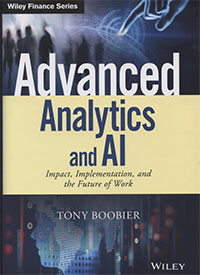The worst thing about the approach of AI isn’t AI itself and what it may or may not bring, it’s the fact that one can no longer fantasize about the future.*
Finally we are beginning to understand what an AI-infused world might look like, with all its opportunities and challenges. It’s also forcing us also to think about our own personal future. If our job can be replaced by automation without anyone noticing the difference, then what value do we, as humans, actually bring?
In insurance, this idea is especially important for intermediaries who must ask themselves, honestly, what value do they currently bring in their discussions with their clients? They need to understand how, in the future, they will be able to bring new benefits and add value to relationships which cannot otherwise be provided by an automated system?
Once we fantasized about an imaginary world of AI, provoked by the fiction of Hollywood. The reality is that a form of AI is with us already. What we watch on TV, how we use social media, and what we purchase by online shopping is constantly influenced by automated and personalised recommendations.
AI comes to us with many different descriptions: Machine learning, cognitive computing, predictive analytics and many other expressions. To the purist these terms aren’t really AI, but to most people these systems represent intelligence within a system that they don’t really understand.
In a future infused with AI:
- Repetitive tasks will be replaced by machine automation
- The cost of doing simple business functions will reduce, and will ultimately improve the profitability of insurers.
- Structured and unstructured data will come together, from both inside and outside the organisation, providing greater actionable insight
- Products and services will be hyper-personalised and match our exact needs precisely.
- Claims processes will increase in speed and accuracy, and the underwriting process will have better pricing.
This new digital environment also brings opportunity for insurers in new product development. There will be a need for new insurance products for digital risks such as cybercrime and autonomous vehicles, and this is a list that will surely grow.
More accurate underwriting, coupled with risk management, will also help carriers provide important social benefit through micro-insurance. This will meet the needs of underserved communities who traditionally have not used insurance, and as a result will open up new, large markets.
Greater emphasis also on ESG will increasingly use automated systems to help in the measurement and strategic delivery of these new key areas of focus.
Fortunately, increased automation will not mean the end of the human touch in insurance, as there will always be a role for human intervention in complicated areas of business. Insurance has always been a multichannel activity, and intermediaries play a vital part in that picture. Robots and humans might need to learn how to work together, side by side.
Industry professionals will also be affected. They will need to learn new skills and adapt to working with advanced techniques. It is said that ‘old dogs cannot learn new tricks’ but the evidence seems to be that many older employees are quite willing to learn new ideas and technologies if their employers are prepared to let them do so.
The issue is increasingly becoming one of acceptance, implementation and of reinvention. The idea of insurance reinventing itself is not new, as it increasingly moves away from being reactive being proactive. Many insurance carriers already provide risk management advice to help reduce losses rather than simply responding by paying for the claim afterwards.
Decisions to automate depend on a clear business case. Effective measurement of benefits and robust performance management are fundamental building blocks on the road to AI transformation.
How an organisation creates new AI capabilities will also vary. Larger organisations with critical mass may decide to develop capabilities using internal resources, but smaller ones may be forced to outsource these capabilities. Companies which build systems internally may have greater control but need to ensure that these systems are fit for purpose, there is strong governance, and that system design is flexible enough to meet the needs of the future.
In an outsourced situation, the way technology vendors are chosen is critical. Selection needs to be based on cultural fit as well as technological ability, ensuring that there are shared cultures and values. The size of the partnering organisations is important as a mismatch in scale can also bring problems, and can prove to be an unhappy marriage.
The time has now come for us to accept that AI will be part of the future of insurance, whether we agree with it or not. The challenge is not just how we effectively implement this new technology, but how we deal with the consequences at a business and personal level.
*After Javier Marías


